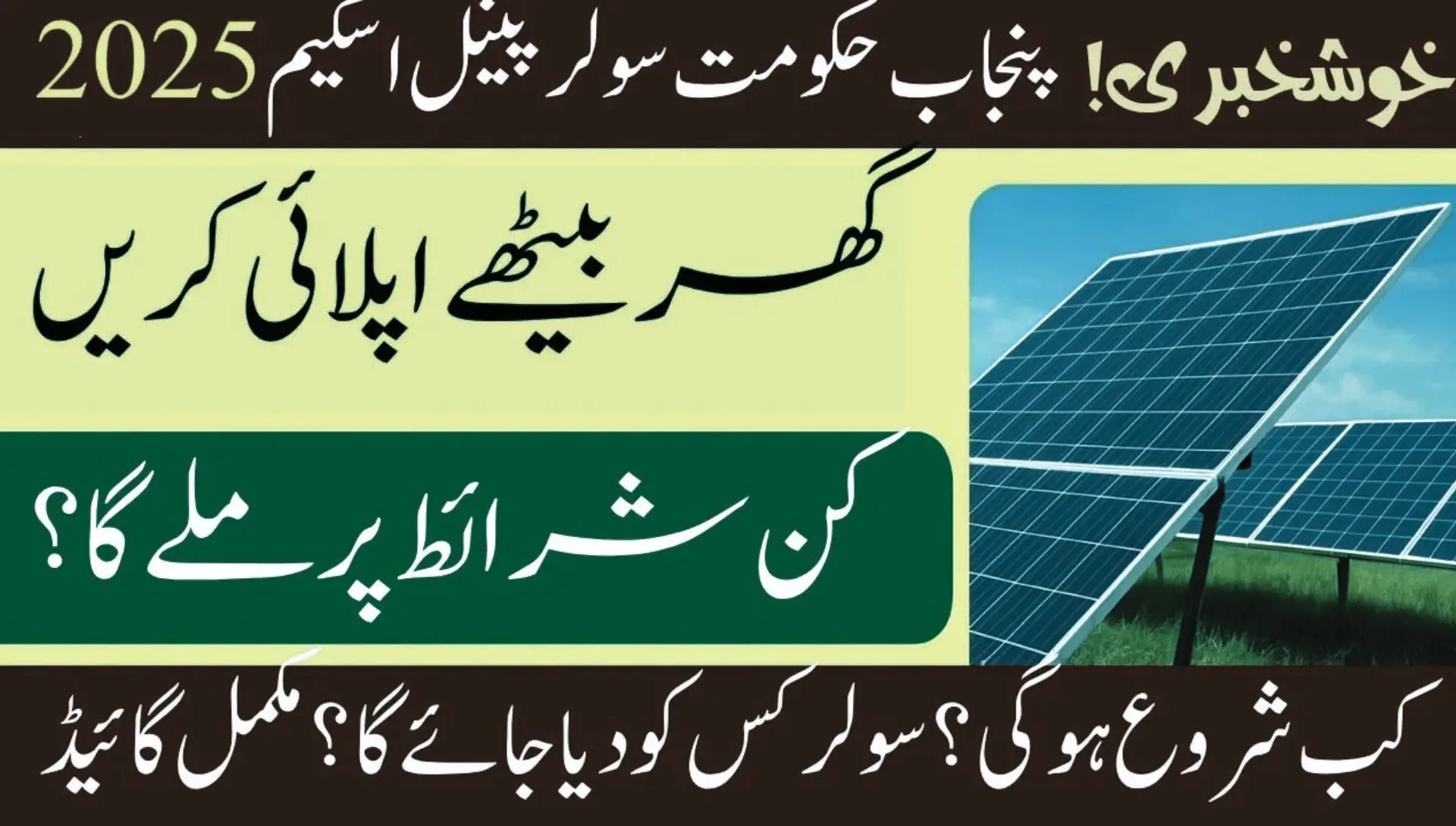Punjab Solar Plate Scheme 2025: Apply Now Before Deadline

Punjab Solar Plate Scheme 2025: Apply Now Before Deadline. The Punjab Solar Plate Scheme 2025 has officially been launched by the Government of Punjab to help households fight the burden of rising electricity bills. Under this new initiative, eligible families consuming 300 units or more will get six solar plates either free of cost or through an easy installment plan via Punjab Bank.
we will walk you through how this scheme works, its benefits, and how you can apply before the official deadline.
Why the Punjab Solar Plate Scheme Matters
Electricity shortages and high tariffs have become daily struggles for many families in Punjab. Despite paying thousands every month, people still face load-shedding and inconsistent supply.
The Punjab Solar Plate Scheme 2025 directly addresses these issues by:
- Providing financial relief to low- and middle-income households.
- Promoting renewable energy usage across Punjab.
- Reducing dependency on WAPDA for electricity supply.
- Helping Pakistan move toward sustainable energy solutions.
This project ensures that poor and middle-class families not only save money but also enjoy a more reliable, cleaner source of power.
Key Features of the Punjab Solar Plate Scheme 2025
| Feature | Description |
|---|---|
| No. of Solar Plates | Six (6) solar panels per eligible household |
| Cost | Free for poor families / Easy installments for others via Punjab Bank |
| Eligibility Usage | Must consume at least 300 electricity units monthly |
| Priority Beneficiaries | Low & middle-income families struggling with bills |
| Purpose | Cut electricity costs and promote clean energy |
| Deadline | Apply before official closing date (2025 announcement expected soon) |
Each solar setup will include panels, an inverter, and basic installation to help families produce their own electricity and reduce dependence on the national grid.
Eligibility Criteria
To keep the distribution transparent, the Punjab Government has set clear conditions:
- Applicant must be a resident of Punjab.
- Household must consume 300 units or more per month.
- Applicant must hold a valid CNIC (renew if expired).
- One application per household only.
- Preference given to poor and middle-class families.
Families using less than 300 units are not eligible. This ensures the scheme supports those most burdened by heavy electricity expenses.
Step-by-Step Online Registration Process
The Punjab Government has made registration easy and digital. Follow these steps once the official portal goes live:
- Visit the official Punjab Solar Plate Scheme Portal.
- Enter your CNIC number, full name, and mobile number.
- Provide your residential address and household details.
- Upload a copy of your latest electricity bill (300+ units).
- Double-check all entries to avoid errors.
- Click Submit Application to complete registration.
Applicants should provide accurate information only. Any false data (such as incorrect CNIC or bill details) will lead to disqualification.
Tip: Keep a screenshot of the submitted form and track updates on the official portal or through SMS notifications.
Punjab Bank Solar Loan Facility
For middle-income families who don’t qualify for free distribution, the Punjab Bank Solar Loan option offers an affordable solution.
How It Works
- Visit the nearest Bank of Punjab branch with your CNIC and electricity bill.
- The bank verifies your information and consumption history.
- If approved, you’ll get a solar loan covering installation and equipment.
- Repayment can be made through easy monthly installments.
This system helps families shift to solar without the burden of a large up-front cost. You can start saving on electricity bills immediately while paying off the loan gradually.
Latest Updates (October 2025)
- Solar panel distribution has started in multiple districts of Punjab.
- Delays occur mostly due to expired CNICs or low unit usage.
- Verification teams are actively cross-checking applicant data.
- The government plans to expand the scheme to cover rural areas next.
If you haven’t applied yet, keep your documents ready — the final phase is expected soon.
Benefits of the Punjab Solar Plate Scheme 2025
| Benefit | Description |
|---|---|
| Free Electricity Generation | Households can produce their own energy and save money. |
| Financial Relief | Huge reduction in monthly electric bills for eligible families. |
| Eco-Friendly | Solar energy reduces carbon emissions and pollution. |
| Energy Independence | Less reliance on WAPDA and fuel imports. |
| Long-Term Savings | Solar systems are durable and require minimal maintenance. |
This scheme is not just a temporary relief measure but a major step towards Pakistan’s sustainable energy future.
How Solar Panels Help Households
Solar energy offers multiple advantages for families in Punjab:
- Stable Power Supply: Minimizes load-shedding issues.
- Lower Costs: Once installed, solar electricity is almost free.
- Increased Property Value: Homes with solar systems sell faster.
- Government Support: Eligible families receive subsidies and tax reliefs.
By investing in solar, families are contributing to both financial and environmental stability in Punjab.
Documents Required for Application
- Original and valid CNIC
- Electricity bill showing 300+ units consumption
- Proof of residence (rent agreement or property document)
- Contact number linked to CNIC
- Recent passport-size photo (optional)
Keep these ready before the online portal opens to save time.
Government’s Vision Behind the Scheme
According to Punjab officials, the goal is to help citizens cope with inflation while reducing pressure on the national grid.
Chief Minister Punjab announced that the scheme will focus on three key areas:
- Affordability – Free or easy financing options.
- Accessibility – Online application and digital monitoring.
- Sustainability – Shifting towards renewable energy sources.
This initiative is expected to power over 100,000 homes by the end of 2025.
Challenges and Solutions
| Challenge | Government Response |
|---|---|
| Delays in distribution | Increasing installation teams province-wide |
| False applications | Strict CNIC and bill verification |
| Awareness gap | SMS alerts and local advertising campaigns |
| Maintenance support | Partner companies for after-sales service |
The Punjab Government is ensuring that this program remains transparent, efficient, and beneficial to deserving families.
How to Track Your Application Status
Once you apply online, you can track your application in two ways:
- Via Portal: Use the “Check Status” option on the official website.
- Via SMS: Send your CNIC number to the designated short code (shared after registration).
You will receive confirmation regarding your eligibility and delivery schedule.
Expected Impact on Punjab’s Energy Sector
- Reduction in electric load on national grid.
- Boost in local solar manufacturing and employment.
- Promotion of green economy and climate resilience.
- Estimated annual savings of up to 20,000 PKR per family.
This initiative can become a model for other provinces if implemented successfully.
FAQs — Punjab Solar Plate Scheme 2025
Q1. Who can apply for the Punjab Solar Plate Scheme 2025?
Only residents of Punjab who consume 300 or more electricity units per month and have a valid CNIC are eligible.
Q2. Is the solar plate scheme completely free?
It is free for poor families. Middle-income families can avail the easy installment option through Punjab Bank.
Q3. How many solar plates will each household get?
Each eligible family will receive six (6) solar plates with basic installation.
Q4. Where can I apply for the scheme online?
You can apply via the official Punjab Solar Plate Scheme portal once the government announces the website link.
Q5. What if my electricity usage is below 300 units?
Unfortunately, families consuming less than 300 units per month are not eligible for this program.
Conclusion
The Punjab Solar Plate Scheme 2025 is a transformative initiative to empower families with clean, affordable, and independent energy sources. By offering free or subsidized solar panels to eligible households, the Punjab Government is paving the way for a brighter and more sustainable future.















